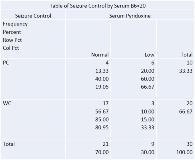Serum Pyridoxine Level and Seizure Control in Adult Epilepsy Patients
Abstract number :
2.299
Submission category :
8. Non-AED/Non-Surgical Treatments (Hormonal, alternative, etc.)
Year :
2018
Submission ID :
503123
Source :
www.aesnet.org
Presentation date :
12/2/2018 4:04:48 PM
Published date :
Nov 5, 2018, 18:00 PM
Authors :
Daniel A. Graf, Emory University; Rafael M. Rodriguez, University of Texas Medical Branch; Prashant Rai, University of Texas Medical Branch; and Todd Masel, University of Texas Medical Branch
Rationale: Vitamin B6 (pyridoxine) is an important cofactor in the process by which glutamic acid decarboxylase (GAD) converts the excitatory, pro-epileptogenic neurotransmitter glutamate into the inhibitory, anti-epileptogenic neurotransmitter GABA. This concept has been well illustrated in infants with pyridoxine dependent epilepsy as well as other causes of infantile spasms, in which vitamin B6 administration is successfully used to augment the process by which GAD converts glutamate to GABA, resulting in a cessation of seizures. Additionally, reports of adult patients with epilepsy subtypes other than pyridoxine dependent epilepsy who present with status epilepticus refractory to conventional AED therapy and found to have low B6 levels responded to pyridoxine administration with termination of status epilepticus. Given our knowledge of the role of pyridoxine in the conversion of glutamate to GABA and its effect on seizure control, it is reasonable to suspect that low vitamin B6 levels in adult epileptic patients may correlate with poor seizure control across epilepsy subtypes. We sought to determine whether there is a correlation between pyridoxine levels and seizure control in adults with epilepsy in the clinic setting. Methods: Institutional Review Board approval was obtained to conduct a retrospective case series of 30 patients with epilepsy, regardless of subtype, who presented consecutively to our clinic and agreed to participate in the study. Prisoners and pregnant women were excluded from the study. Once informed consent was obtained, patients were classified as well controlled (WC) or poorly controlled (PC) based on the absence or presence of a seizure within the last 3 months, respectively, barring extenuating circumstances thought to have precipitated the seizure(s), such as missed doses of medication, severe sleep deprivation, or systemic illness. After classification into WC or PC groups, the patients had their serum pyridoxine and AED levels drawn the same day. All patients who were found to have vitamin B6 deficiency were treated with appropriate supplementation, regardless of their level of seizure control, and all patients received appropriate AED therapy commensurate to their condition. Results: In total, 32 patients were recruited for the study. Two patients were removed from analysis as they did not meet study criteria, having been found to have psychogenic non-epileptic events. Of the 30 patients meeting study criteria, 10 were determined to have PC epilepsy. Of those 10 with PC epilepsy, 6 had low vitamin B6 levels. Patients who had a low serum pyridoxine level represented 60% of the PC group compared to 15% (3/20) in the WC group. The majority (6/9 or 66.67%) of patients with low serum pyridoxine levels had poorly controlled epilepsy. Statistical analysis using Fisher’s Exact Test found that there was a statistically significant (p=0.03) correlation between low vitamin B6 levels and poorly controlled epilepsy. There was no statistically significant correlation between gender and seizure control. Wilcoxon rank sum test was used to compare the median age between the two seizure groups (WC and PC) and no significant association was found between age and the two seizure groups. Conclusions: Our data suggest a correlation between serum pyridoxine level and seizure control. No correlation was found with age or gender. Due to its retrospective nature, our study cannot determine causality, and future prospective studies are planned to determine if pyridoxine supplementation shifts patients towards better seizure control. If appropriate, pyridoxine supplementation may be added to the epileptologist’s existing armamentarium to improve seizure control. Funding: Funding was provided by the UTMB Department of Neurology.

.tmb-.jpg?Culture=en&sfvrsn=8a7332c5_0)